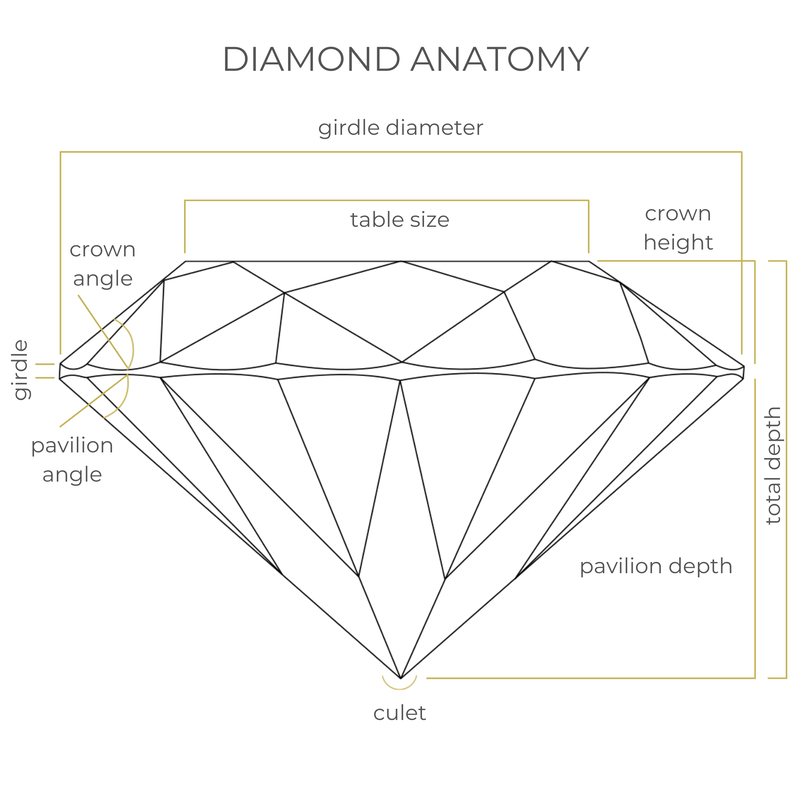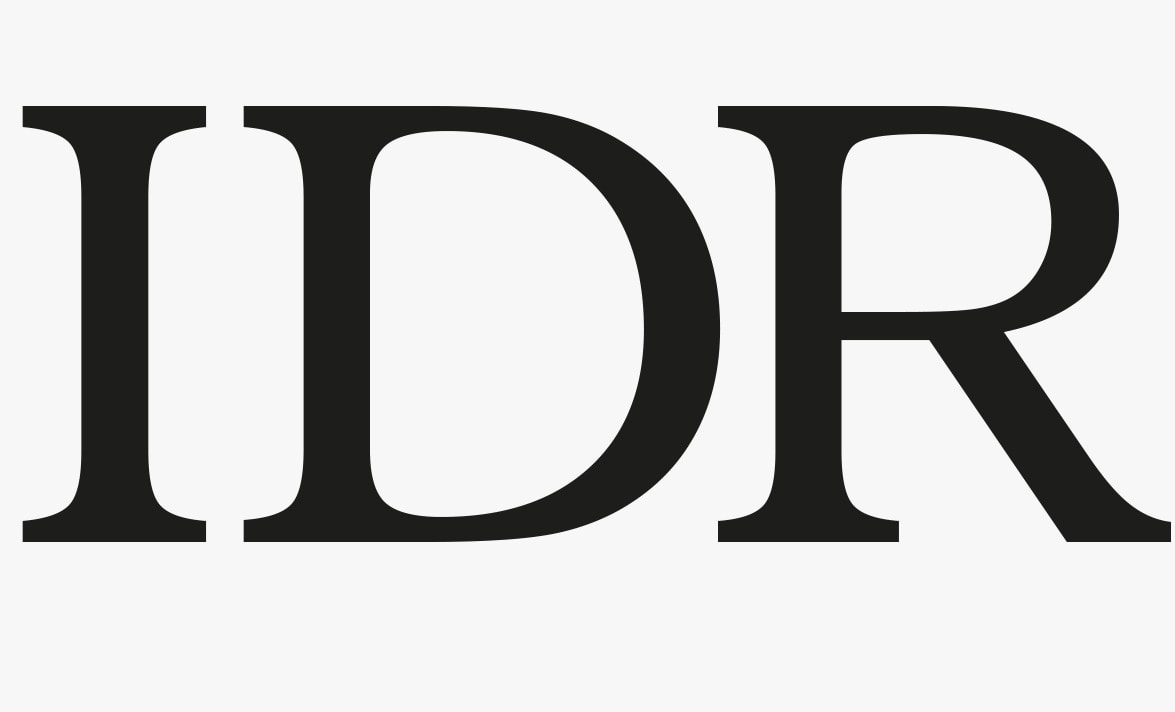DIAMOND ANATOMY
Once cut and polished, all diamonds possess a shared set of characteristics, often referred to as the anatomy of the diamond. While the individual proportions, angles and placement of these common characteristics vary for diamonds of different shapes, their definition is the same.
In the standard round brilliant, there are 57 or 58 facets. The table facet, usually the largest facet on the diamond, helps gather light from above and either reflects it back to the observer or directs it into the diamond’s interior. The crown facets, consisting of 8 bezels, 8 stars, and 16 upper halves, gather and disperse light to create brightness, fire, and a scintillating pattern of light and dark. The pavilion facets, consisting of 16 lower halves, 8 mains, and an optional culet, reflect the light back through the crown to the viewer’s eye. All of these facets work together creating each diamond’s unique appearance.
In the standard round brilliant, there are 57 or 58 facets. The table facet, usually the largest facet on the diamond, helps gather light from above and either reflects it back to the observer or directs it into the diamond’s interior. The crown facets, consisting of 8 bezels, 8 stars, and 16 upper halves, gather and disperse light to create brightness, fire, and a scintillating pattern of light and dark. The pavilion facets, consisting of 16 lower halves, 8 mains, and an optional culet, reflect the light back through the crown to the viewer’s eye. All of these facets work together creating each diamond’s unique appearance.
1 |
2 |
3 |
4 |
5 |
6 |
7 |
8 |
9 |
10 |
Table |
Crown |
Girgle |
Pavilion |
Culet |
Bezel Facets |
Upper Girdle |
Star Length |
Lower Girgle |
Pavilion Facets |
1 TABLE
The table percentage of a round brilliant diamond is the average of four table measurements (from bezel point to bezel point) expressed as a percentage of the average girdle diameter. It is reported to the nearest whole percent (1%).
The table percentage is a calculated value obtained by the following formula:
Table % = (average table size ÷ average girdle diameter) x 100
Table size can have a significant impact on the diamond’s face-up appearance, especially when it’s paired with certain combinations of crown and pavilion angles.
2 CROWN ANGLE & HEIGHT PERCENTAGE
Crown angle is the measured angle between the bezel facet plane and the table plane. The average of eight crown angle measurements is reported to the nearest half of a degree (0.5°).
Crown height percentage is the diamond’s crown height, measured from the table to the intersection of the bezel facet and the girdle, expressed as a percentage of its average girdle diameter. It is reported to the nearest half of a percent (0.5%).
Crown height percentage is a calculated value obtained by the following formula:
Crown height % = (average crown height ÷ average girdle diameter) x 100
3 GIRDLE THICKNESS PERCENTAGE
Girdle thickness percentage is the average thickness of a diamond’s girdle, measured at the eight bezel/main “hill” positions, and expressed as a percentage of average girdle diameter. Hill positions are the “thick places” located where the bezel and main facets meet. It is reported to the nearest half of a percent (0.5%). Girdle thickness is visually assessed at the "valley" positions, as a range between the thinnest (minimum) and the thickest (maximum) areas. Valley positions are the "thin places" located between the bezel/main intersection and where the upper and lower halves meet.
Descriptions of girdle thickness include extremely thin, very thin, thin, medium, slightly thick, thick, very thick, and extremely thick. Thinner girdles can affect the diamond’s durability, whereas thicker girdles can hide unnecessary weight. The cut grade can be lowered in both of these cases.
4 PAVILION ANGLE & DEPTH PERCENTAGE
Pavilion angle is the measured angle between the pavilion main facet plane and the table plane. Pavilion depth percentage is the diamond’s pavilion depth, measured from the culet to the intersection of the pavilion main facet and the girdle, expressed as a percentage of its average girdle diameter. It is reported to the nearest half of a percent (0.5%).The average pavilion depth percentage is a calculated value obtained by the following formula:
Pavilion depth % = (average pavilion depth ÷ average girdle diameter) x 100
5 CULET SIZE
Culet size is described as the width of the culet facet, when present, relative to a round diamond’s average girdle diameter. Descriptions include none, very small, small, medium, slightly large, large, very large, and extremely large.
"None" is used when there is no culet facet, which is sometimes referred to by the trade as a “pointed” culet.
Larger culets can have a negative effect on the diamond’s face-up appearance, specifically affecting its pattern, and lowering its cut grade.
6 BEZEL
Also known as the “crown mains,” the bezel facets are diamond shaped and sit between the table and the girdle edge. There are 8 bezel facets on a round brilliant. The bezels can significantly affect a diamond’s face-up appearance. Generally, bezel's angles from 32 to 36 degrees produce attractive, bright, and fiery diamonds if combined with the right table percentage and pavilion angle.
7 UPPER GIRDLE
The upper girdle facets (the facets forming the lower section of the kite shapes on the crown) can also be a problem if not polished into correct shapes. The idea of the upper girdle facets is to provide many additional angles to send light in a combination of many different directions. By the same token, these facets must be polished in a shape that is pleasing under 10x. The configuration of the perfect kite shapes is part of the very important symmetry that you will get used to recognizing. On a full crown (e.g. 58% table, 34 degrees angles), the upper girdle facets will generally be polished to a height of just over 50% (of girdle to table) to achieve the proper kite shapes. This also helps the stars (eight triangular facets edging the table) to fall into their ideal equilateral, triangular shapes. The thinner the crown, the shorter the stars will have to be, in order to achieve an attractive kite shape, and the fuller the crown (fuller than acceptable standards), the longer the stars will have to be.
8 STAR LENGTH
Star length percentage is the length of the star facet expressed as a percentage of the girdle-to-table distance. The average of the eight star length percentages is reported to the nearest five percent (5%). Star facets that are very short or very long can have a negative effect on a diamond’s face-up appearance.
9 LOWER-HALF
Lower-half length percentage is the length of a pair of lower-half facets expressed as a percentage of the girdle-to-culet distance. The average of eight lower-half length percentages is reported to the nearest five percent (5%). Lower-half facets that are very short or very long can have a negative effect on a diamond’s face-up appearance, especially its pattern.
10 PAVILION FACETS
The average of eight pavilion angle measurements is reported to the nearest 0.2 degrees.Subtle pavilion facets differences can have a significant impact on the diamond’s face-up appearance. For instance, steep pavilion facets can produce dark areas under the diamond’s table.
The table percentage of a round brilliant diamond is the average of four table measurements (from bezel point to bezel point) expressed as a percentage of the average girdle diameter. It is reported to the nearest whole percent (1%).
The table percentage is a calculated value obtained by the following formula:
Table % = (average table size ÷ average girdle diameter) x 100
Table size can have a significant impact on the diamond’s face-up appearance, especially when it’s paired with certain combinations of crown and pavilion angles.
2 CROWN ANGLE & HEIGHT PERCENTAGE
Crown angle is the measured angle between the bezel facet plane and the table plane. The average of eight crown angle measurements is reported to the nearest half of a degree (0.5°).
Crown height percentage is the diamond’s crown height, measured from the table to the intersection of the bezel facet and the girdle, expressed as a percentage of its average girdle diameter. It is reported to the nearest half of a percent (0.5%).
Crown height percentage is a calculated value obtained by the following formula:
Crown height % = (average crown height ÷ average girdle diameter) x 100
3 GIRDLE THICKNESS PERCENTAGE
Girdle thickness percentage is the average thickness of a diamond’s girdle, measured at the eight bezel/main “hill” positions, and expressed as a percentage of average girdle diameter. Hill positions are the “thick places” located where the bezel and main facets meet. It is reported to the nearest half of a percent (0.5%). Girdle thickness is visually assessed at the "valley" positions, as a range between the thinnest (minimum) and the thickest (maximum) areas. Valley positions are the "thin places" located between the bezel/main intersection and where the upper and lower halves meet.
Descriptions of girdle thickness include extremely thin, very thin, thin, medium, slightly thick, thick, very thick, and extremely thick. Thinner girdles can affect the diamond’s durability, whereas thicker girdles can hide unnecessary weight. The cut grade can be lowered in both of these cases.
4 PAVILION ANGLE & DEPTH PERCENTAGE
Pavilion angle is the measured angle between the pavilion main facet plane and the table plane. Pavilion depth percentage is the diamond’s pavilion depth, measured from the culet to the intersection of the pavilion main facet and the girdle, expressed as a percentage of its average girdle diameter. It is reported to the nearest half of a percent (0.5%).The average pavilion depth percentage is a calculated value obtained by the following formula:
Pavilion depth % = (average pavilion depth ÷ average girdle diameter) x 100
5 CULET SIZE
Culet size is described as the width of the culet facet, when present, relative to a round diamond’s average girdle diameter. Descriptions include none, very small, small, medium, slightly large, large, very large, and extremely large.
"None" is used when there is no culet facet, which is sometimes referred to by the trade as a “pointed” culet.
Larger culets can have a negative effect on the diamond’s face-up appearance, specifically affecting its pattern, and lowering its cut grade.
6 BEZEL
Also known as the “crown mains,” the bezel facets are diamond shaped and sit between the table and the girdle edge. There are 8 bezel facets on a round brilliant. The bezels can significantly affect a diamond’s face-up appearance. Generally, bezel's angles from 32 to 36 degrees produce attractive, bright, and fiery diamonds if combined with the right table percentage and pavilion angle.
7 UPPER GIRDLE
The upper girdle facets (the facets forming the lower section of the kite shapes on the crown) can also be a problem if not polished into correct shapes. The idea of the upper girdle facets is to provide many additional angles to send light in a combination of many different directions. By the same token, these facets must be polished in a shape that is pleasing under 10x. The configuration of the perfect kite shapes is part of the very important symmetry that you will get used to recognizing. On a full crown (e.g. 58% table, 34 degrees angles), the upper girdle facets will generally be polished to a height of just over 50% (of girdle to table) to achieve the proper kite shapes. This also helps the stars (eight triangular facets edging the table) to fall into their ideal equilateral, triangular shapes. The thinner the crown, the shorter the stars will have to be, in order to achieve an attractive kite shape, and the fuller the crown (fuller than acceptable standards), the longer the stars will have to be.
8 STAR LENGTH
Star length percentage is the length of the star facet expressed as a percentage of the girdle-to-table distance. The average of the eight star length percentages is reported to the nearest five percent (5%). Star facets that are very short or very long can have a negative effect on a diamond’s face-up appearance.
9 LOWER-HALF
Lower-half length percentage is the length of a pair of lower-half facets expressed as a percentage of the girdle-to-culet distance. The average of eight lower-half length percentages is reported to the nearest five percent (5%). Lower-half facets that are very short or very long can have a negative effect on a diamond’s face-up appearance, especially its pattern.
10 PAVILION FACETS
The average of eight pavilion angle measurements is reported to the nearest 0.2 degrees.Subtle pavilion facets differences can have a significant impact on the diamond’s face-up appearance. For instance, steep pavilion facets can produce dark areas under the diamond’s table.
© IDR ( INTERNATIONAL DIAMOND REPORT ) 2021


